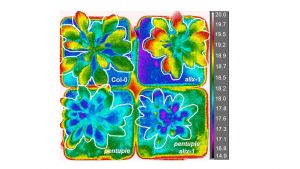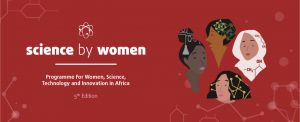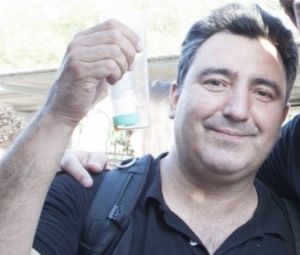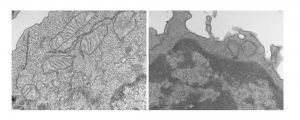J Nanobiotechnology. 2019 Aug 6;17(1):87
Sanz-Ortega L, Portilla Y, Pérez-Yagüe , Barber DF.
Abstract
BACKGROUND: Adoptive T cell-transfer (ATC) therapy is a highly promising cancer-treatment approach. However, in vivo-administered T cells tend to disperse, with only a small proportion reaching the tumour. To remedy this, magnetic targeting of T cells has been recently explored. Magnetic nanoparticles (MNPs) functionalised with antibodies were attached to effector T cells and magnetically recruited to tumour sites under MRI guidance. In this study, we investigated whether 3-aminopropyl-triethoxysilane (APS)-coated MNPs directly attached to CD8+ T cell membranes could also magnetically target and accumulate tumour-specific CD8+ T cells in solid tumours using an external magnetic field (EMF). As it has been shown that T cells associated with APS-coated MNPs are retained in lymph nodes (LNs), and tumour-draining LNs are the most common sites of solid-tumour metastases, we further evaluated whether magnetic targeting of APS-MNP-loaded CD8+ T cells could cause them to accumulate in tumour-draining LNs.
RESULTS: First, we show that antigen-specific CD8+ T cells preserve their antitumor activity in vitro when associated with APS-MNPs. Next, we demonstrate that the application of a magnetic field enhanced the retention of APS-MNP-loaded OT-I CD8+ T cells under flow conditions in vitro. Using a syngeneic mouse model, we found similar numbers of APS-MNP-loaded OT-I CD8+ T cells and OT-I CD8+ T cells infiltrating the tumour 14 days after cell transfer. However, when a magnet was placed near the tumour during the transfer of tumour-specific APS-MNP-loaded CD8+ T cells to improve tumour infiltration, a reduced percentage of tumour-specific T cells was found infiltrating the tumour 14 days after cell transfer, which was reflected in a smaller reduction in tumour size compared to tumour-specific CD8+ T cells transferred with or without MNPs in the absence of a magnetic field. Nonetheless, magnet placement near the tumour site during cell transfer induced infiltration of activated tumour-specific CD8+ T cells in tumour-draining LNs, which remained 14 days after cell transfer.
CONCLUSIONS: The use of an EMF to improve targeting of tumour-specific T cells modified with APS-MNPs reduced the percentage of these cells infiltrating the tumour, but promoted the retention and the persistence of these cells in the tumour-draining LNs.
doi: 10.1186/s12951-019-0520-0.
- El equipo de Vicente Rubio ha identificado un mecanismo por el cual las plantas regulan de manera precisa la respuesta a las variaciones en la disponibilidad del agua.
Los estomas son unos pequeños poros que se encuentran en las hojas y los tallos de las plantas, a través de los cuales se realiza el intercambio gaseoso. Sin embargo, también son la vía por la se pierde el agua a través de la transpiración. En condiciones de sequía, las plantas cierran los estomas mediante un proceso que está controlado por el ácido abscísico (ABA), una hormona vegetal que se sintetiza cuando la planta detecta la falta de agua.
En el artículo del Dr. Vicente Rubio, publicado en The Plant Cell, han identificado una factor de Arabidopsis, ALIX, una proteína de membrana que interacciona con los receptores de ABA y regula su tráfico y posterior degradación en la vacuola.
García-León M, Cuyas L, Abd El-Moneim D, Rodriguez L, Belda-Palazon B, Sánchez-Quant E, Fernández Y, Roux B, Zamarreño AM, Garcia-Mina JM, Nussaume L, Rodriguez PL, Paz-Ares J, Leonhardt N, Rubio V.
Abstract
The plant endosomal trafficking pathway controls abundance of membrane-associated soluble proteins, as shown for abscisic acid (ABA) receptors (PYR/PYL/RCAR). ABA receptor targeting for vacuolar degradation occurs through the late endosome route and depends on FYVE1 and VPS23A, components of endosomal sorting complex required for transport (ESCRT)-I complexes. FYVE1 and VPS23A interact with ALIX, an ESCRT-III-associated protein, although the functional relevance of such interactions and their consequences in cargo sorting are unknown. Here we show that ALIX directly binds to ABA receptors in late endosomes, promoting their degradation. Impaired ALIX function leads to altered endosomal localization and increased accumulation of ABA receptors. In line with this, partial loss-of-function alix-1 mutants display ABA hypersensitivity during growth and stomatal closure, unveiling a role for the ESCRT machinery in the control of water loss through stomata. ABA hypersensitive responses are suppressed in alix-1 plants impaired in PYR/PYL/RCAR activity, in accordance with ALIX affecting ABA responses primarily by controlling ABA receptor stability. ALIX-1 mutant protein displays reduced interaction with VPS23A and ABA receptors, providing a molecular basis for ABA hypersensitivity in alix-1 mutants. Our findings unveil a negative feedback mechanism triggered by ABA acting via ALIX to control the accumulation of specific PYR/PYL/RCAR receptors.
doi: 10.1105/tpc.19.00399.
J Antimicrob Chemother. 2019 Aug 1.
Blanco P, Corona F, Martinez JL.
Abstract
OBJECTIVES: To elucidate the potential mutation-driven mechanisms involved in the acquisition of tigecycline resistance by the opportunistic pathogen Stenotrophomonas maltophilia. The mutational trajectories and their effects on bacterial fitness, as well as cross-resistance and/or collateral susceptibility to other antibiotics, were also addressed.
METHODS: S. maltophilia populations were submitted to experimental evolution in the presence of increasing concentrations of tigecycline for 30 days. The genetic mechanisms involved in the acquisition of tigecycline resistance were determined by WGS. Resistance was evaluated by performing MIC assays. Fitness of the evolved populations and individual clones was assessed by measurement of the maximum growth rates.
RESULTS: All the tigecycline-evolved populations attained high-level resistance to tigecycline following different mutational trajectories, yet with some common elements. Among the mechanisms involved in low susceptibility to tigecycline, mutations in the SmeDEF efflux pump negative regulator smeT, changes in proteins involved in the biogenesis of the ribosome and modifications in the LPS biosynthesis pathway seem to play a major role. Besides tigecycline resistance, the evolved populations presented cross-resistance to other antibiotics, such as aztreonam and quinolones, and they were hypersusceptible to fosfomycin, suggesting a possible combination treatment. Further, we found that the selected resistance mechanisms impose a relevant fitness cost when bacteria grow in the absence of antibiotic.
CONCLUSIONS: Mutational resistance to tigecycline was easily selected during exposure to this antibiotic. However, the fitness cost may compromise the maintenance of S. maltophilia tigecycline-resistant populations in the absence of antibiotic.
doi: 10.1093/jac/dkz326
- 15 research centers of excellence including the CNB will host African scientists from January 2020
Science by Women programme promotes African women’s leadership in scientific research and technology transfer and to foster the capacity of the research centres in their home countries. The programme´s ultimate goal is to enable African women researchers to play a leading role in the transition of Africa to a knowledge-based and innovation-led economy through research in health, agriculture and food security, water, energy and climate change, as well as mathematics and economic science that can be transferred into products, processes, services and technologies having impact on people´s lives.
Researchers interested in applying for a stay at the National Biotechnology Center should contact the research groups of their interest beforehand to obtain an acceptance letter that needs to be attached in their application
More information about the program and the submission of applications on the program website
Tras el fallecimiento de nuestro compañero Carlos Enríquez, desde el CNB expresamos nuestro dolor por su pérdida y mandamos un fuerte abrazo a su familia.
Le recordamos con las emotivas palabras de Lluís Montoliu
Un centro de investigación es una pequeña ciudad. Una colectividad en la que convive mucha gente, que va sucediéndose a lo largo de los años, cada cual realizando su función, para que todo el engranaje siga rodando perfectamente. En un centro coinciden los investigadores, de diversos tipos (en formación, postdoctorales, visitantes, responsables de grupo), el personal administrativo y de servicios (limpieza, seguridad, cafetería, etc…) y por supuesto el personal técnico y de apoyo a los laboratorios, quienes contribuyen con su trabajo a la adecuada ejecución de los proyectos de investigación. Muchas veces se trata de personas transparentes. Frecuentemente no reparamos en su trabajo, aunque su labor sea fundamental. Su presencia es esencial para que todo funcione correctamente, para que las logísticas y las rutinas departamentales sigan operativas sin que nadie se percate. Para que los reactivos y soluciones estén en el cajón o el estante donde esperamos encontrarlas. Siempre listas. Siempre a punto.
Carlos Enríquez era uno de estos técnicos de nuestro centro. Probablemente estaba entre quienes llevamos más años conviviendo en el CNB, más de 25 años en su caso. Había pasado por diversos laboratorios y por diversos servicios. Ahora llevaba ya muchos años de técnico de nuestro departamento de biología molecular y celular, encargado de la preparación y facturación de los medios y soluciones para cultivos celulares de los laboratorios de la primera planta del CNB. Su personalidad extrovertida y su irrefrenable gusto por la conversación espontánea, a todas horas, hacía inevitable que cualquiera de los habitantes del centro no le conociera. Todos recordamos en algún momento haber escuchado sus historias, sus aficiones, sus achaques, sus chistes. Reconozco que, en más de una ocasión, sin tiempo para detenerme a conversar, le había dado una palmadita en la espalda, tras saludarlo, emplazándole a otro momento para hablar. Y su respuesta era siempre una sonrisa, con la que te reconfortaba la mala conciencia que te quedaba por no haber podido detenerte a charlar con él.
Carlos Enríquez estaba cuando se le necesitaba. Nos había hecho favores a todos. Recordaba detalles personales de cada uno de nosotros, de dónde éramos, nuestras familias, nuestras vacaciones, etc… Por supuesto, a raíz de su afición por la fotografía muchos recordaremos las fotos de grupo que nos tomó, fuera y dentro del CNB. O para echarnos una mano en cualquier remodelación de los laboratorios. Estaba presente en las fiestas, en las actividades sociales y culturales, en el grupo de teatro, en la coral del campus, y en muchos otros grupos espontáneos que se formaron en el centro a lo largo de todos estos años.
Tampoco olvidaba sus orígenes en el CBMSO, donde coincidió con Antonio Varas y Luis Yuste, que también se trasladaron al CNB, abordando la secuenciación del genoma del virus de la peste porcina, bajo la supervisión de Paco Rodríguez, en el laboratorio de Eladio Viñuela. Seguía cultivando la amistad con sus ex-compañeros del CBMSO mediante visitas o comidas periódicas.
Todo ello terminó abruptamente el pasado lunes, 29 de julio, de forma inexplicable. Esta pequeña ciudad que es el CNB perdió uno de sus habitantes. Carlos Enríquez ya no está en el centro, pero su huella y su recuerdo persistirán.
Cancer immunotherapy has become an effective strategy of the antioncological arsenal, but it only works in certain types of cancer and in a limited number of patients. Although the immune system can recognise and eliminate tumor cells, tumors have evasion mechanisms to prevent it. One of them is the expression of PD-L1 protein on the surface of tumors, which blocks the antitumor capacity of cytotoxic CD8 lymphocytes through mechanisms that are still poorly understood.
A group of researchers led by Santos Mañes from the National Center for Biotechnology (CNB-CSIC), has identified PD-L1 mechanism to inactivate cytotoxic cells by altering the mitochondria and reprogramming the cell metabolism and publish their results in the Journal for Immunotherapy of Cancer.
ACS Appl Mater Interfaces. 2019 Jul 22
Del Sol-Fernández S, Portilla-Tundidor Y, Gutiérrez L, Odio OF, Reguera E, Barber DF, Morales MP
Abstract
Despite the potential of magnetic nanoparticles (NPs) to mediate intracellular hyperthermia when exposed to an alternating magnetic field (AMF), several studies indicate that the intracellular heating capacity of magnetic NPs depends on factors such as cytoplasm viscosity, nanoparticle aggregation within subcellular compartments, and dipolar interactions. In this work, we report the design and synthesis of monodispersed flowerlike superparamagnetic manganese iron oxide NPs with maximized SAR (specific absorption rate) and evaluate their efficacy as intracellular heaters in the human tumor-derived glioblastoma cell line U87MG. Three main strategies to tune the particle anisotropy of the core and the surface to reach the maximum heating efficiency were adopted: (1) varying the crystalline anisotropy by inserting a low amount of Mn2+ in the inverse spinel structure, (2) varying the NP shape to add an additional anisotropy source while keeping the superparamagnetic behavior, and (3) maximizing NP-cell affinity through conjugation with a biological targeting molecule to reach the NP concentration required to increase the temperature within the cell. We investigate possible effects produced by these improved NPs under the AMF (f = 96 kHz, H = 47 kA/m) exposure in the glioblastoma cell line U87MG by monitoring the expression of hsp70 gene and reactive oxygen species (ROS) production, as both effects have been described to be induced by increasing the intracellular temperature. The induced cell responses include cellular membrane permeabilization and rupture with concomitant high ROS appearance and hsp70 expression, followed by cell death. The responses were largely limited to cells that contained the NPs exposed to the AMF. Our results indicate that the developed strategies to optimize particle anisotropy in this work are a promising guidance to improve the heating efficiency of magnetic NPs in the human glioma cell line.
Curr Biol. 2019 Jul 22;29(14):2270-2281
Gimenez-Ibanez S, Zamarreño AM, García-Mina JM, Solano R.
Abstract
Evolutionary molecular plant-microbe interactions (EvoMPMI) is an emerging field bridging the gap between molecular phytopathology and evolutionary studies. EvoMPMI research is currently challenging due to the scarcity of pathogenic model systems in early-diverging land plants. Liverworts are among the earliest diverging land-plant lineages, and Marchantia polymorpha has emerged as a liverwort model for evolutionary studies. However, bacterial pathogens of Marchantia have not yet been discovered, and the molecular mechanisms controlling plant-pathogen interactions in this early-diverging land plant remain unknown. Here, we describe a robust experimental plant-bacterial pathosystem for EvoMPMI studies and discover that an ancient immune system governs plant-microbe interactions between M. polymorpha and the hemi-biotrophic pathogenic bacteria Pseudomonas syringae. We show that P. syringae pv tomato (Pto) DC3000, causal agent of tomato bacterial speck disease, colonizes M. polymorpha and activates typical hallmarks of plant innate immunity. Virulence of Pto DC3000 on M. polymorpha relies on effector activities inside liverwort cells, including conserved AvrPto and AvrPtoB functions. Host specificity analyses uncovered pathogenic differences among P. syringae strains, suggesting that M. polymorpha-P. syringae interactions are controlled by the genetic backgrounds of both host and pathogen. Finally, we show that ancient phytohormone defensive networks govern M. polymorpha-P. syringae interactions. Altogether, our results demonstrate that the basic structure of the plant immune system of extant angiosperms is evolutionarily ancient and conserved in early-diverging land plants. This basic immune system may have been instrumental for land colonization by the common ancestor of land plants.
doi: 10.1016/j.cub.2019.05.079
Nucleic Acids Res. 2019 Jul 27
Torres R, Serrano E, Alonso JC
During natural transformation Bacillus subtilis RecA, polymerized onto the incoming single-stranded (ss) DNA, catalyses DNA strand invasion resulting in a displacement loop (D-loop) intermediate. A null radA mutation impairs chromosomal transformation, and RadA/Sms unwinds forked DNA in the 5'→3' direction. We show that in the absence of RadA/Sms competent cells require the RecG translocase for natural chromosomal transformation. RadA/Sms tetracysteine motif (C13A and C13R) variants, which fail to interact with RecA, are also deficient in plasmid transformation, but this defect is suppressed by inactivating recA. The RadA/Sms C13A and C13R variants bind ssDNA, and this interaction stimulates their ATPase activity. Wild-type (wt) RadA/Sms interacts with and inhibits the ATPase activity of RecA, but RadA/Sms C13A fails to do it. RadA/Sms and its variants, C13A and C13R, bound to the 5'-tail of a DNA substrate, unwind DNA in the 5'→3' direction. RecA interacts with and loads wt RadA/Sms to promote unwinding of a non-cognate 3'-tailed or 5'-fork DNA substrate, but RadA/Sms C13A or C13R fail to do it. We propose that wt RadA/Sms interaction with RecA is crucial to recruit the former onto D-loop DNA, and both proteins in concert catalyse D-loop extension to favour integration of ssDNA during chromosomal transformation.
doi: 10.1093/nar/gkz647
COOKIES POLICY
A cookie is a text file that is stored on your computer or mobile device via a web server and only that server will be able to retrieve or read the contents of the cookie and allow the Web site remember browser preferences and navigate efficiently. Cookies make the interaction between the user and the website faster and easier.
General information
This Website uses cookies. Cookies are small text files generated by the web pages you visit, which contain the session data that can be useful later in the website. In this way this Web remembers information about your visit, which can facilitate your next visit and make the website more useful.
How do cookies?
Cookies can only store text, usually always anonymous and encrypted. No personal information is ever stored in a cookie, or can be associated with identified or identifiable person.
The data allow this website to keep your information between the pages, and also to discuss how to interact with the website. Cookies are safe because they can only store information that is put there by the browser, which is information the user entered in the browser or included in the page request. You can not run the code and can not be used to access your computer. If a website encrypts cookie data, only the website can read the information.
What types of cookies used?
The cookies used by this website can be distinguished by the following criteria:
1. Types of cookies as the entity that manages:
Depending on who the entity operating the computer or domain where cookies are sent and treat the data obtained, we can distinguish:
- Own cookies: are those that are sent to the user's terminal equipment from a computer or domain managed by the editor itself and from which provides the service requested by the user.
- Third party cookies: these are those that are sent to the user's terminal equipment from a machine or domain that is not managed by the publisher, but by another entity data is obtained through cookies.
In the event that the cookies are installed from a computer or domain managed by the editor itself but the information collected by these is managed by a third party can not be considered as party cookies.
2. Types of cookies as the length of time that remain active:
Depending on the length of time that remain active in the terminal equipment can be distinguished:
- Session cookies: cookies are a type designed to collect and store data while the user accesses a web page. Are usually used to store information that only worth preserving for the service requested by the user at any one time (eg a list of products purchased).
- Persistent cookies: cookies are a type of data which are stored in the terminal and can be accessed and treated for a period defined by the head of the cookie, and can range from a few minutes to several years.
3. Cookies types according to their purpose:
Depending on the purpose for which the data are processed through cookies, we can distinguish between:
- Technical cookies: these are those that allow the user to navigate through a web page or application platform and the use of different options or services it exist as, for example, control traffic and data communication, identify the session, access to restricted access parts, remember the elements of an order, make the buying process an order, make an application for registration or participation in an event, use security features while browsing store content for dissemination videos or sound or share content via social networks.
- Customization cookies: these are those that allow the user to access the service with some general characteristics based on a predefined set of criteria in the user terminal would eg language, the type of browser through which you access the service, the locale from which you access the service, etc.
- Analysis cookies: they are those that allow the responsible for them, monitoring and analyzing the behavior of users of the web sites that are linked. The information gathered through such cookies are used in measuring the activity of web sites, application or platform and for the profiling of user navigation of such sites, applications and platforms, in order to make improvements function data analysis how users use the service.
Management tool cookies
This Website uses Google Analytics.
Google Analytics is a free tool from Google that primarily allows website owners know how users interact with your website. Also, enable cookies in the domain of the site in which you are and uses a set of cookies called "__utma" and "__utmz" to collect information anonymously and reporting of website trends without identifying individual users..
For statistics of use of this website use cookies in order to know the level of recurrence of our visitors and more interesting content. This way we can concentrate our efforts on improving the most visited areas and make the user more easily find what they are looking for. On this site you can use the information from your visit for statistical evaluations and calculations anonymous data and to ensure the continuity of service or to make improvements to their websites. For more details, see the link below privacy policy [http://www.google.com/intl/en/policies/privacy/]
How to manage cookies on your computer: disabling and deleting cookies
All Internet browsers allow you to limit the behavior of a cookie or disable cookies within settings or browser settings. The steps for doing so are different for each browser, you can find instructions in the help menu of your browser.
If you decline the use of cookies, since it is possible thanks to the preferences menu of your browser or settings, reject, this website will continue to function properly without the use of the same.
Can you allow, block or delete cookies installed on your computer by setting your browser options installed on your computer:
- For more information about Internet Explorer click here.
- For more information on Chrome click here.
- For more information about Safari click here.
- For more information about Firefox click here.
Through your browser, you can also view the cookies that are on your computer, and delete them as you see fit. Cookies are text files, you can open and read the contents. The data within them is almost always encrypted with a numeric key corresponding to an Internet session so often has no meaning beyond the website who wrote it.
Informed consent
The use of this website on the other hand, implies that you paid your specific consent to the use of cookies, on the terms and conditions provided in this Cookies Policy, without prejudice to the measures of deactivation and removal of cookies that you can take, and mentioned in the previous section.









